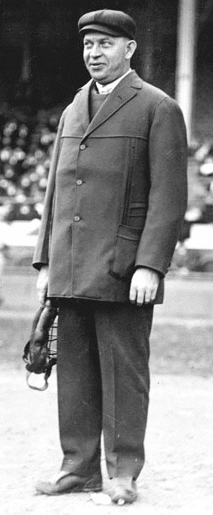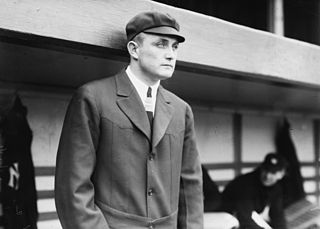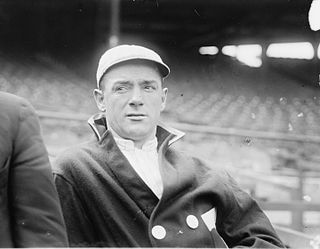
The Society for American Baseball Research (SABR) is a membership organization dedicated to fostering the research and dissemination of the history and record of baseball, primarily through the use of statistics. The organization was founded in Cooperstown, New York, on August 10, 1971, at a meeting of 16 “statistorians” coordinated by sportswriter Bob Davids. The organization now reports a membership of over 7,500 and is based in Phoenix, Arizona.

John Bertrand "Jocko" Conlan was an American baseball umpire who worked in the National League (NL) from 1941 to 1965. He had a brief career as an outfielder with the Chicago White Sox before entering umpiring. He umpired in five World Series and six All-Star Games. He was elected to the Baseball Hall of Fame in 1974 by the Veterans Committee.

Edward Augustine Walsh was an American pitcher and manager in Major League Baseball, nicknamed "Big Ed". From 1906 to 1912, he had several seasons where he was one of the best pitchers in baseball. Injuries shortened his career. Walsh holds the record for lowest career earned run average, 1.82. He is one of two modern (post-1901) pitchers to win 40 or more games in a single season, and the last pitcher to do so. He is the last pitcher from any team to throw more than 400 innings in a single season, a feat he accomplished in 1907 and 1908. He was inducted into the Baseball Hall of Fame in 1946.

William Joseph Klem, known as "the Old Arbitrator", was an American baseball umpire who worked in Major League Baseball from 1905 to 1941, spending his entire career in the National League (NL). He worked 18 World Series, which is a major league record. Klem was posthumously inducted into the Baseball Hall of Fame in 1953.

William Aloysius McGowan was an American umpire in Major League Baseball who worked in the American League from 1925 to 1954. McGowan founded the second umpire school in the United States. He was inducted into the National Baseball Hall of Fame in 1992, the first person born in Delaware so honored.

William George Evans, nicknamed "the Boy Umpire", was an American umpire in Major League Baseball (MLB) who worked in the American League from 1906 to 1927. He became, at age 22, the youngest umpire in major league history, and later became the youngest to officiate in the World Series at age 25.

Albert Joseph Barlick was an American umpire in Major League Baseball who worked in the National League for 28 seasons. Barlick missed two seasons (1944–45) due to service in the United States Coast Guard and two seasons (1956–57) due to heart problems. He umpired seven World Series and seven All-Star Games.

William Francis Carrigan, nicknamed "Rough", was an American Major League baseball catcher and manager. He played for the Boston Red Sox between 1906 and 1916, and he was a player-manager for the last four of those seasons. In 1915 and 1916, Carrigan's teams won back-to-back World Series. He was said to exert a positive influence on young Red Sox star Babe Ruth, serving as his roommate and his manager. He has the highest postseason winning percentage (.800) of any manager with multiple postseason appearances, and was named to the Honor Rolls of Baseball in 1946.

Thomas Henry Connolly was an English-American umpire in Major League Baseball. He officiated in the National League from 1898 to 1900, followed by 31 years of service in the American League from 1901 to 1931. In over half a century as an American League umpire and supervisor, he established the high standards for which the circuit's arbiters became known, and solidified the reputation for integrity of umpires in the major leagues.

Frederick George Lieb was an American sportswriter and baseball historian. Lieb published his memoirs in 1977, which documented his nearly 70 years as a baseball reporter. He received the J. G. Taylor Spink Award from the Baseball Writers' Association of America in 1972. Born in 1888 in Philadelphia, Lieb died at age 92 in Houston.

Robert Daniel Emslie was a Canadian pitcher in Major League Baseball (MLB) who went on to set numerous records for longevity as an umpire. Born in Guelph, Ontario, Canada, Emslie had a brief professional playing career with the Baltimore and Philadelphia clubs in the American Association.

John Arnold Heydler was an American executive in Major League Baseball. After working as a National League (NL) umpire, he was the secretary to the NL president and then became the secretary-treasurer of the NL before assuming the NL presidency himself. Heydler made early contributions to baseball recordkeeping and statistics.

Charles Frederick "Heinie" Wagner was an American baseball player and manager. He played shortstop for the New York Giants (1902) and the Boston Red Sox (1906–1918). He was also the manager of the Red Sox during the 1930 baseball season.

John Edward Briggs is an American former professional baseball left fielder who played in Major League Baseball (MLB) for the Philadelphia Phillies (1964–1971), Milwaukee Brewers (1971–1975), and Minnesota Twins (1975). He batted and threw left-handed, and was listed as 6 feet 1 inch (1.85 m) tall and 190 pounds (86 kg).

Philip Joseph "Babe" Marchildon was a Canadian professional baseball player. A right-handed pitcher, he played in Major League Baseball (MLB) for the Philadelphia Athletics and Boston Red Sox between 1940 and 1950. Listed at 5 feet 10 inches (1.78 m) and 175 pounds (79 kg), he was inducted to the Canadian Baseball Hall of Fame in 1983.

Eugene Abraham "Red" Desautels was an American professional baseball player. He played most of his Major League Baseball career as a backup catcher with four teams between 1930 and 1946. Desautels was a light-hitting player, but was known for his superior defensive ability as a catcher, and for his handling pitching staffs. After his playing career, he served as a manager in minor league baseball.

Timothy Carroll Hurst was an American sports official who worked as an umpire and manager in Major League Baseball and as a boxing referee in championship fights.

The Worcester Worcesters, sometimes referred to as the Brown Stockings or the Ruby Legs, were a Major League Baseball team based in Worcester, Massachusetts. Though the team's alternate names appear in many modern sources, no contemporary records from the time exist that support the use of names other than "Worcester". They existed in the National League (NL) from 1880 to 1882, and played their home games at the Worcester Agricultural Fairgrounds.

Samuel Wright Jr. was an American professional baseball player. He played in Major League Baseball for a total of four seasons for the New Haven Elm Citys (1875), Boston Red Caps, and Cincinnati Stars (1880).

Thomas J. Lynch was an umpire in Major League Baseball for 13 seasons, all of which were in the National League (NL), between the years of 1888 and 1902. Known as an honest, but sometimes brash umpire, he later became NL president in 1910 as a compromise among the major league owners. Although his time as league president was considered uneventful, he was replaced following the 1913 season.


























